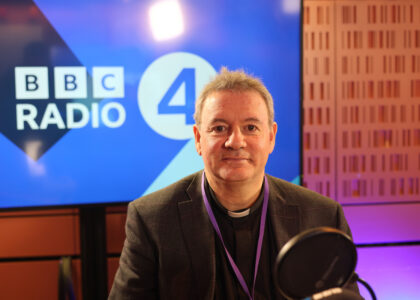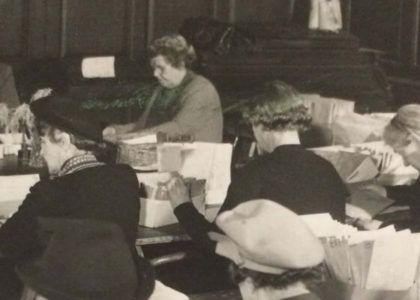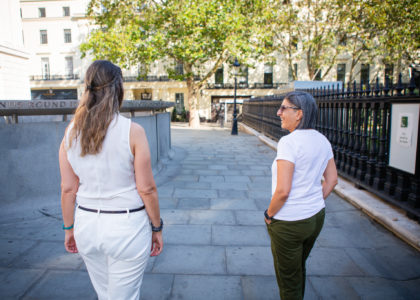By Charlotte Aughey
On Sunday 6th January 1924 at 6.15pm the British Broadcasting Cooperation (B.B.C.) broadcast the first religious service live from the pulpit of St Martin-in-the-Fields at the request of the Religious Committee of the B.B.C. Considered controversial at the time, the broadcast fundamentally sought to reach those who were unable to attend regular church services whilst also actively helping Christians to understand and live their faith in a more enriching way. After the initial broadcast the B.B.C. received nearly a thousand letters from all over the country and for the majority the broadcast was hailed a success, with listeners describing it as ‘spelling binding’, ‘thrilling’ and ‘an intellectual treat’. However, some loyal churchgoers had a less favourable reaction, as they saw religious broadcasting as a ‘travesty on Christian worship’, ‘harmful to true religion’ and sacrilegious. Consequently a letter of protest was received by the B.B.C. and published in the February edition of the St Martin’s Review. In it the Vicar of St Stephen’s Norbury, Rev. A. G Edwards, stated:
“I have taken the greatest interest in the B.B.C. almost since it was started, and I have always rejoiced that it has fixed its broadcasting on Sundays at times when usual Services are not being held in churches. And now it is you – a clergyman – who have broken that custom and have set on foot a practice of having a kind of entertainment (for it can be called nothing else) during the time of Evening Service”
Although the Rev. Edwards clearly objected to the religious service broadcast, much of the clergy rejoiced in the freedom that broadcasting afforded them and saw broadcasting as a way of maintaining standards of truth, justice and honesty while also encouraging ‘non-churchgoers’ to be active members of the Christian community. Furthermore it was a way of bringing the family together, Sybil Allen, a long-time friend of St Martins, describes listening to it as a child:
“I can remember sitting in a field hearing the Christmas Appeal as a child, would have been when Pat McCormick was here and Dick Sheppard was a visiting preacher. It was something one had to listen to when it was going out, if you were at home listening to the radio, perhaps it’s just my family but we had to listen to it.” Sybil Allen
Unbeknown to many the tradition of broadcasting religious services goes back as far as 1895, when as noted in an early edition of the St Martin’s Review, churches were pioneering the use of the Electrophone. The electrophone was created by the Electrophone Company and was a kind of ‘cable radio’ service which offered a selection of live relays from London theatres, music halls, opera houses and later St Martin’s. A controversial topic even then, electrophones had to be disguised as tables, lights and even bibles so as not to cause an uproar amongst the more traditional members of the congregation. As with later religious broadcasting, the use of the electrophone did raise some concerns, some worried that they “might be reduced to carrying out services in a perfectly empty church” (as the congregation would remain unseen), whilst others worried that the atmosphere of the service might be lost in the broadcast; I am pleased to report that these fears were not realised.
By 1951 one third of the adult population of the United Kingdom were listening to the broadcasts being relayed by St Martin’s, with the majority being older and from working class backgrounds. What has this got to do with the Christmas Appeal I hear you ask! Quite simply, the St Martin’s Christmas Appeal could not raise the sums of money it has or help the amount of people it does if it were not for the pioneering work of the B.B.C and Rev. Dick Sheppard, for it was through one of his early December broadcast that the first Christmas Appeal was made.
The Christmas Appeal, the story so far…….
For many St Martin’s annual Christmas Appeal is as familiar at Christmas time as mince pies and crackers. Over its long and illustrious history millions of pounds have been raised and thousands have regularly tuned in to listen to the annual appeal given by the Vicar of St Martin’s. Its continued presence on the airwaves has made it a much loved tradition and a favourite among many.
The origins of the Christmas Appeal or ‘Christmas Fund’, can be traced back to the end of the First World War and the pioneering work of Revd. Hugh Richard Lawrie Sheppard or ‘Dick Sheppard’ as he was affectionately known. For it was he who first recognised that there was a need to help those who had fallen on hard times after the War. Consequently, he sought to collect funds which could be directly distributed to families and individuals during both the summer months and the festive season, this led to the creation of the Holiday Fund and the Christmas Appeal. The Holiday Fund, although discontinued by the B.B.C in 1939, sought to raise funds to enable families to go on much needed holidays, whilst the Christmas Appeal aimed to give families the means to have those ‘little extras’ so loved by everyone at Christmas.
It is clear from early copies of the St Martin’s Review that prior to the Christmas Appeal, Dick Sheppard was already making regular appeals for donations for various church projects, including the Churchwardens, Vicars General Fund and various overseas charities. But the first specific mention of the Christmas Appeal came on Sunday 5th December 1920 when, at the end of the service, Dick Sheppard asked members of the congregation to donate money so that those less fortunate could have ‘treats and happiness at Christmas’. These more informal Christmas Appeals made by Dick Sheppard each December continued privately until 1925. Early editions of the St Martin’s Review show that by December 1925 the Christmas Appeal was being incorporated into the broadcasted service. Below is an excerpt from the January 1926 edition of the St Martin’s Review, in which Dick Sheppard thanked the ‘broadcasting public’ for their continued generosity:
“May we say how really grateful we were to those who responded so generously to our Appeal for our Special Christmas Fund. We were enabled to ensure that many homes and individuals had some slight measure of Christmas cheer which, but for this Fund, would have been altogether wanting. We are especially grateful to our Broadcasting Public.”
Although it is unclear how much money these early direct appeals raised, it is evident that they had a profound effect on not only those receiving donations but also Dick Sheppard himself. By 1927 the Christmas Appeal began to be included in the December edition of the Radio Times, thus marking the beginning of the Christmas Appeal as we recognise it today. The Christmas Appeal during this time was concerned with helping the ‘hidden poor’, i.e. those normally outside the reach of organised charity. Reasons for help varied considerably but a common thread running throughout was that all the recipients had recently found themselves on hard times. Appeal donations were addressed directly to the Vicar who was then responsible for distributing the funds, however as the Appeal continued, this huge undertaking became too big a task for one man and so the Vicar relied on a team of ‘distributers’ from all over the country to help identify those in need. Nonetheless it was the Vicar alone who was accountable to the B.B.C and subscribing public for the administration of funds raised by the appeal and therefore took his responsibilities very seriously. Confidentiality and anonymity were of the highest priority and so the Vicar in charge never disclosed how much money had been donated and to whom. By the 1930’s as the appeal grew in size and popularity the B.B.C’s Central Appeals Advisory Committee (established in 1924) felt it necessary to formalise the appeal, and so suggested a series of rules which Revd. Pat McCormick and any future Vicars must follow. Firstly, they suggested that there should be a separate St Martin’s Appeals Committee to oversee the distribution of funds, of which the resident Vicar would be Chairman. Secondly, St Martin’s must receive receipts from distributors for each donation so as to avoid overlapping. Thirdly and finally there must be an annual report and audit conducted which would then be sent to the B.B.C Appeals Department. St Martin’s complied and the Appeal continued to be broadcast. Contrary to popular opinion there was never a formal agreement between St Martin’s and the B.B.C to broadcast the Christmas Appeal, the Vicar needed to write to the B.B.C Appeals Department each year to ask for permission, of course this was always acknowledged and accepted. The Christmas Appeal continued to be broadcast without fuss throughout the 1930s and 1940’s except for 1940 and 1947 when the sudden deaths of Rev. Pat McCormick and Rev. Eric Loveday left St Martin’s without a Vicar. Although there were no formal Christmas Appeals broadcast at this time, St Martin’s still received a large number of donations.
1956 saw the appointment of the hugely popular Revd. Austen Williams. A stalwart of St Martin’s for nearly thirty years, Austen Williams was by all accounts a natural broadcaster and it was under his direction that the Christmas Appeal blossomed into the nationally and internationally recognised appeal it is today. It was during Austen’s tenure that the Christmas Appeal first raised six figures, (£102, 4310 to be precise), an extraordinary achievement which could not have been possible without the B.B.C and the generosity of listeners. As Austen Williams’ tenure came to an end in 1984 the St Martin’s Christmas Appeal was annually raising funds of nearly £91,000, which increased to £216,000 by 1997.
Where does the money go?
People often wonder what becomes of their donation to the Christmas Appeal, and the answer is simple, it goes far and wide to help those in need. Throughout its history St Martin’s has always been the first to help vulnerable members of the community and consequently has been the birthplace of many other organisations seeking to do the same, including Shelter, Crisis and The Big Issue.
At present the money raised via the Christmas Appeal is divided between the Vicar’s Relief Fund (VRF) and The Connection. The Vicar’s Relief Fund is a long established fund at St Martin’s which aims to support people all across the country who are at risk of being made homeless or who are vulnerable. The money raised is distributed in the shape of a grant, which can be used as a deposit for more permanent housing or as a rent payment to help remove the threat of eviction. Grants can also be given for household items such as beds, cookers and fridges. The average grant is around £280 and can often be given within two days of St Martin’s receiving a request. Much like Dick Sheppard’s time, the requests for donations received by St Martin’s are only accepted from support workers or other professionals on behalf of the service user, this enables St Martin’s to make sure that the funds get to the most deserving cases.
The Connection at St Martin’s is another beneficiary of the Appeal donations. It is a registered homelessness charity which was created by merging the Social Care Unit which operated out of St Martin’s for many years and the London Connection, a service specifically working with young people. The Connection is an organisation tasked with helping those who are either homeless or at risk of being homeless. This is predominantly achieved through their day centre, which offers food, shower and laundry facilities as well as regular health advice centres and regular activities offered at the centre. Although welcoming people throughout the year, Christmas is a particularly special time at The Connection as it annually provides people with a Christmas lunch and festive cheer.





